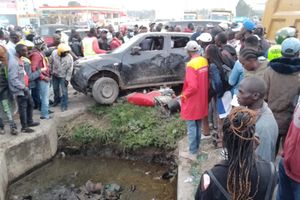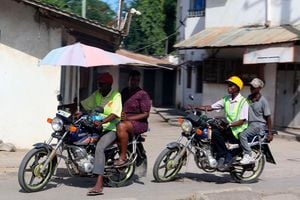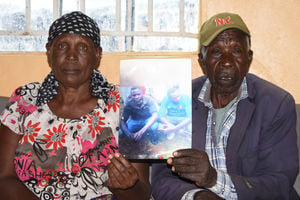
An overloaded bodaboda.
One in every three Kenyans who died in road accidents over the past six years was either riding on a motorcycle or was hit by the two-wheeled speed machines that dot roads and pedestrian walks across the country.
Together, motorcyclists and pillion passengers constituted 8,432 out of the 24,312 road accident deaths that were reported between 2018 and 2023, based on data on road accidents in the country.
Over the past decade, about 70,000 road accidents occurred in the country, leaving behind a trail of misery in many homes. The lives of more than 120,000 Kenyans who were left with injuries changed forever.
More than 36,000 lives were lost to road accidents between 2014 and 2023, taking away parents, siblings and friends. People who left home thinking they were on return trips encountered their final journeys.
As road accidents continue to rob families across the country of their loved ones and leave thousands with traumas, one section of road users who have found themselves in the greatest danger of death on the roads are those riding motorcycles, who account for a third of the reported road accident deaths.
The killer boda bodas have grown exponentially over the past two decades, taking a huge share of Kenya’s informal sector economy and employing hundreds of thousands of youths in every corner of the country.
But authorities reckon that road accidents involving motorcyclists and pedestrians are nearing a tipping point. The National Transport and Safety Authority (NTSA) in its 2023-2027 national road safety action plan noted that “Some hospitals now have a ward dedicated to victims of motorbike crashes and 80 percent of the patients in the Spinal Injury Hospital are victims of traffic crashes.”

An overloaded bodaboda.
The boda boda industry supports Kenya’s economy in a big way, acting as a handy job alternative for a huge chunk of Kenyan youths. They make it possible for Kenyans to access remote corners where conventional vehicles can’t reach. A mix of factors have, however, turned the Boda boda industry into a jungle of sorts.
The unruliness they operate with on the roads raises their risk of causing freak accidents, and the sector is prone to exploitation by criminals.
In the streets of Nairobi City, motorcycles ride in disregard of traffic rules. They aggressively speed on the wrong lanes, disregard traffic lights, and run across walk paths under the noses of traffic police officers.
In different parts of the country, boda bodas carrying excessive passengers and huge loads that pose risks to themselves and other road users are normal sights.
The cost of this notoriety, data now reveals, has been many deaths and injuries. About 219 motorcyclists and pillion passengers died in road accidents that occurred in the first seven weeks of this year. This was a third of all the 649 road accident deaths that were reported in the year to February 20, according to the NTSA.
“Another important objective is to establish effective regulatory control over the safety of Boda Boda (motorcycle taxis) and develop a long-term plan for motorcycle safety. This will help address the specific risks associated with motorcycles and ensure their safe operation,” the NTSA notes in its road safety action plan.
In a proposed motorcycle safety plan, the Authority has recommended harsher consequences for motorcyclists who offend the law, “to turn around the gross non-compliance that is killing and maiming so many Kenyans.”
The biggest casualties of road accidents over the past decade have been pedestrians, who account for 36.2 percent of reported deaths, data shows.
This has been the unintended consequence of the expansive road infrastructure that the country has heavily invested in. While intended to ease the movement of people and goods to steer economic growth, the smooth roads have turned into death traps, claiming lives almost daily and causing untold economic losses.
Data shows that out of the 1.7 million Kenyans who died in the country between 2014 and 2023, 36,160 of them died in road accidents. The road accident deaths, however, could be four times higher, according to World Health Organization (WHO) estimates.
In 2022, road accidents took away 4,690 out of the 213,210 Kenyans who lost their lives, which meant that for every 45 Kenyans who died that year, one was on road crashes, a trend worse than the decade average of one road accident death out of every 50 deaths in Kenya.
In the seven weeks ending February 20, 2024, 649 died on the roads, a weekly average of 92 road accident deaths, higher than the weekly average of 83 road accident deaths through 2023.
With roads opening up even the remotest of Kenyan villages, so has the increase in the number of deaths. The NTSA was established to enforce safety on the roads more than 10 years ago.

Boda boda operators along Moi Avenue in Nairobi rest on top of their motorcycles as they wait for customers on January 11, 2023.
Despite its existence since 2012, the number of Kenyans dying on the roads over the past decade has grown by about two-thirds and is nearing 5,000 deaths annually.
In its 2023-2027 National Road Safety Action Plan, the Authority attributes the increase in road accidents to a rapid increase in human and vehicle populations “which have in turn led to rapid increases in traffic.”
“The whole road traffic system in Kenya in its current state cannot cope, and very large numbers of people are being killed and seriously injured as a result.
“The current road safety situation is concerning, especially in the face of a rapidly growing vehicle fleet. Vulnerable road users, especially pedestrians and motorcyclists, are the most at risk. That being the case, pedestrian and motorcyclist (and pillion) safety is a major and ongoing concern, and the road environment needs to be made much safer for them,” the NTSA says.
Responding to questions sent by the Nation on why Kenyans have continued to die in road accidents despite the existence of rules guiding the usage of safety belts, speed limits, an inspection of vehicles and control of number of passengers on public service vehicles, NTSA said this was due to an incomplete speed and traffic violations management system, indicating that it is “at an advanced stage of developing and implementing speed and traffic violations management system” and that once complete, “it will bring all PSVs and PSVs into our real-time span of monitoring.”
The NTSA also says that it relies on cooperation from stakeholders in the transport sector to ensure that speed limiters are functioning correctly and that some drivers have not been complying with traffic regulations on speed and lane discipline.
The Authority also relies on transport operators “to ensure that their vehicles are inspected to assure on their roadworthiness and ensure that tampering of the speed limiters after inspection does not occur.”
It says it has conducted road safety audits and black spot mapping, whose findings informed decisions such as the separation of the carriageway in Sachangwan, Nakuru County.
On paper, the NTSA has a plan to reduce the number of people dying of road accidents by half from the 4,690 who lost their lives in 2022, but this could be a tall order, given the challenges it faces.
Pedestrians have always constituted a majority of the people who die in road accidents, more than motorcyclists and pillion passengers combined.
“This is a culture that the Authority is continuously working to eliminate. The majority of pedestrians are not conscious of road safety and engage in risky behaviours such as walking in the middle of the roads, crossing in undesignated areas, and failing to use footbridges,” NTSA told Nation.
The Authority says that video data it collected at 38 blackspots in Nairobi showed that less than a quarter of Nairobians use designated crosswalks even where they are available.

Authorities reckon that road accidents involving motorcyclists and pedestrians are nearing a tipping point.
In November 2020, the Auditor-General released a performance audit on the maintenance of road infrastructure, which revealed glaring loopholes in road designs and consideration for safety during construction and maintenance, which could have contributed to most of the road accidents witnessed.
The audit established that in most of the roads across the country, road signs had been abandoned, vandalised or not been considered during construction and that some road sections with steep slopes and points lacked guard rails.
“During physical verification of road furniture on the sampled roads between January and March 2019, it was noted that various warning signs for bumps, bends and pedestrian crossing were missing at crucial locations. Analysis of data collected during inspection of the sampled roads shows that out of the 459 road bumps recorded, 254 had signage while 205 did not have signs to warn motorists,” the audit stated.
“Absence of these critical road furniture poses a safety risk to road users. Lack of safety fences such as guardrails renders limited or no protection to road users. In addition, the absence of markings in areas where traffic is expected to slow down exposes road users to the dangers of collision or knocking down pedestrians as they approach the bus bay. Eventually, there is an increased likelihood of road injuries and fatalities which could have been avoided,” the audit concluded.
Some of the roads with the greatest number of vandalised road furniture, the audit found, were ones where the most fatal crashes have been witnessed, including Gilgil-Mau Summit, Machakos-Kitui and Mariakani- Kaloleni- Mavueni roads.
The audit followed some of the worst road crashes witnessed on Kenyan roads, including two that had claimed 95 lives, acknowledging that road accidents were partly caused by lack of or inappropriately placed road furniture. At the time, the National Police Service had listed 78 roads as being blackspots.
“It is alarming that lives are lost yet installation of the appropriate furniture could have prevented the accidents to a large extent,” the Auditor-General regretted, noting that the government had spent Sh150 billion in four years, part of which could have been targeted at boosting safety on the roads.
NTSA records show that fatal road accidents are concentrated within specific roads and counties, with Nairobi, Nakuru, Machakos, and Kiambu- accounting for 36 percent of the fatal crashes in 2022.
“Many crashes occur on the Northern Corridor, which drives the large percent of fatalities that occur in the counties that this corridor crosses. Five roads in Nairobi County, representing 2 percent of the road network, account for 36 percent of all fatal crashes in the county,” the NTSA also notes.
The NTSA also notes that 26 percent of the fatal crashes in Nairobi occur between 7 pm and 10 pm, just after the main rush hour period which allows higher speeds. “During these later hours, lack of visibility and alcohol can play an important role.”
Kenya had a road network of over 100,000 kilometres by June last year, after the government spent Sh1.44 trillion to building 11,000 kilometers of roads in a decade.

Tabitha Muthoni gives poridge to her son Jackson Kinyanjui a boda boda accident victim during an interview at their home in Kijabe on February 23, 2024.
While the vast road network has had a huge impact on the country’s economy, accidents occurring on them are not only causing untold pain to Kenyans who are losing their loved ones and sustaining life-threatening injuries, but also costing the economy about Sh450 billion every year, according to NTSA.
The Sh450 billion annual economic losses from road accidents are more than three times the current financial year’s health budget and almost six times the entire budget to run free primary and day secondary education this year.
It is also almost ten times the Sh50 billion budget planned for the maintenance of roads.
“The annual socioeconomic losses in Kenya as a result of road crashes are estimated to be over Sh450 billion. There is a need to sustainably finance road safety programs and cost-effective safety investments in Kenya over the next decade,” the NTSA says.
The regulator is pushing for the establishment of a National Road Transport and Safety Fund, which would allow for the imposition of a safety levy on any services it renders, premiums received by insurance companies for motor vehicles' third-party covers, and require that 10 percent of revenue collected from motor vehicle registration, inspection and issuance of driver licenses be channeled to the fund, to be deployed in conducting audits on road transport safety and implementing road safety strategies.
“This creates an opportunity for the NTSA as the lead agency for road safety in Kenya to manage a dedicated road safety fund, which may be allocated across the critical areas of activity set out in this National Road Safety Action Plan, and in pursuit of the national road safety vision and targets,” it says.
The NTSA also notes that while traffic police remain critical players in the achievement of safety on Kenyan roads, corruption within the service is a huge impediment.
“Particular attention will be given to developing and implementing a comprehensive anticorruption program within NPS traffic operations. This will promote a specific set of ethical standards for traffic policing, establish processes for addressing corrupt or unethical behaviour within traffic policing, and support the use of traffic policing technology such as electronic ticketing that can eliminate corruption,” it notes in its action plan.
This is besides the push to have local universities and engineering bodies in the country incorporate star rating training in road assessment programs such as the International Road Assessment Programme, and programmes on road crash investigation and prevention, road safety audit, and non-motorised safety treatments.
Noting that road accident deaths have grown by about two-thirds over the past decade, the NTSA told the Nation that “this remains an issue of big concern to NTSA – a life lost is a life too many.”
“This challenges us to do more and we are actually doing this (through the introduction of) Intelligent Road Safety Management System – Upon completion, we will be able to monitor all PSVs and HCVs for speeding, route discipline, fatigue management, carrying capacity management, driving behaviour, among others.”











